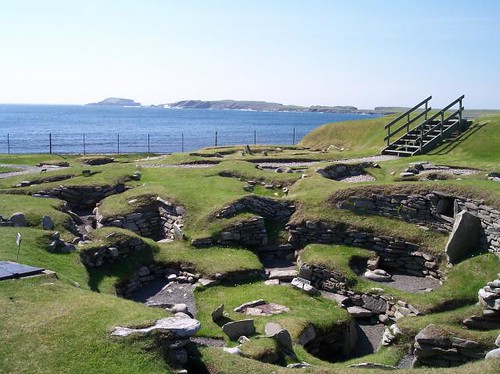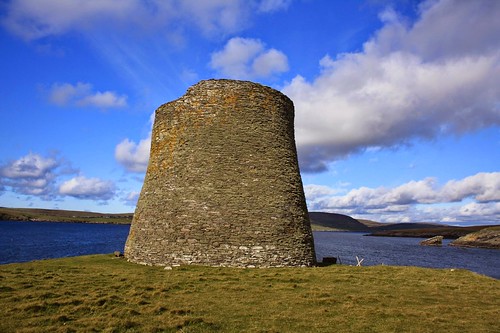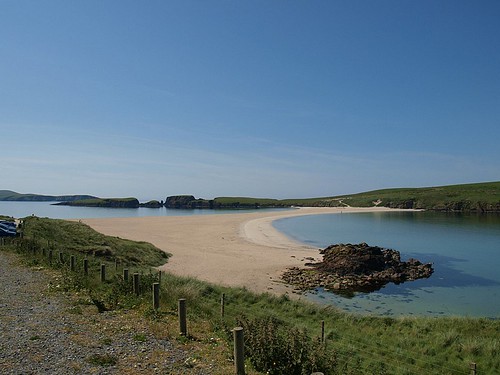South Mainland
===Introduction to South Mainland=== Phone code: +44 (0)1950
From Lerwick a long, narrow finger of land points south. The main road runs down the east coast for 25 miles till it ends at Sumburgh Head, near Shetland's main airport. This southern part of the Shetland Mainland holds the islands' two most important archaeological sights and main tourist attractions.
About 10 miles south of Lerwick, just to the south of Cunningsburgh, is the Catpund Quarries, where soft soapstone was quarried from Neolithic to medieval times, and made into a variety of stone implements and utensils.
Region
Shetland IslandsLocal Sights & Activities for South Mainland
Mousa
Fifteen miles south of Lerwick, the scattered crofting communities of Sandwick look across to the Isle of Mousa, site of the best-preserved broch in Scotland. This fortified tower was built around 2,000 years ago and still stands close to its original height of 45 ft. It's a very impressive structure when you see it from the inside and has chambers, galleries, an internal staircase and a parapet. The broch features in a Viking saga of the 12th century when the mother of Harald, Earl of Orkney, took refuge there with her lover. The Earl, who did not approve of the liaison, laid siege to the broch, but it proved impregnable and he gave up.
Mousa island is also home to many seabirds and waders, most notably the Storm Petrel, which is best seen at dusk as they return to their nests amongst the beach rocks. You can also see seals on the white-sand beach at West Voe. If you have time, it's a good idea to walk right around the coast, starting from the landing stage at West Ham and first heading south to the broch. Allow about 2 hrs, and watch out for dive-bombing terns.
A passenger ferry sails to the island from Leebitton harbour in Sandwick daily from mid-April to mid-September, weather permitting, at 0930, 1230 and 1400, allowing visitors 2€ hours to see the island. The trip takes 15 minutes and costs £10.00 per adult and £5.00 per child. For bookings, call Tom Jamieson.
Entry to the broch is free
South of Sandwick
At Hoswick, between Sandwick and Levenwick, is Da Warp and Weft Visitor Centre, which houses an exhibition on weaving, crofting, fishing and island life. Info - May-Sep Mon-Sat 1000-1700, Sun 1200-1700. Free. Next door is the Shetland Woollen Company, where you can buy knitwear.
Further south on the east coast, at Boddam, is the Shetland Crofthouse Museum, a restored thatched crofthouse with 19th-century furniture and utensils. Info - May-Sep daily 1000-1300 and 1400-1700. £2.
St Ninian's Isle to Quendale
On the west coast, near Bigton village, a signposted track leads to the spectacular sandy causeway (known as a tombolo) which leads to St Ninian's Isle. The tombolo is the best example of its kind in Britain, and you can walk across to the island which is best known for the hoard of Pictish treasure which was discovered in 1958 in the ruins of the 12th-century church. The 28 silver objects included bowls, a spoon and brooches, probably dating from around 800 AD, and are now on display in the Royal Scottish Museum in Edinburgh, though you can see replicas in the Shetland Museum in Lerwick. Two daily buses (not Sunday) run to Bigton from Lerwick, though you have to change at Channerwick junction.
The west coast south of Bigton is beautiful with long, sandy beaches interspersed with dramatic cliff scenery. On the other side of the road from the long, sheltered beach at Scousburgh Sands is the Loch of Spiggie RSPB Reserve. The loch is an important winter wildfowl refuge, particularly for Whooper Swans, and during the summer you can see various ducks, waders, gulls, terns and skuas. There's a hide on the northern shore with an information board. Nearby is the Spiggie Hotel, Tel. 01950-460409, which offers bar meals, afternoon tea or dinner. A few miles south of the loch is the village of Quendale, overlooking a wide, sandy bay. Here you'll find the beautifully restored 19th-century Quendale Mill, the last of Shetland's watermills. Info - 14th April to 15th October daily 1000-1700. Adult £2.00 - Senior Citizens £1.00 - Children £0.50.
Not far from here, between Garth's Ness and Fitful Head, lies the wreck of the Braer oil tanker which ran on to the rocks in 1993. A disaster of epic proportions was averted by the hurricane-force gales which dispersed the huge oil spillage.
Transport
Two buses daily (Mon-Sat) run to Quendale from Lerwick, with a change at Channerwick junction.
Sumburgh & Jarlshof
At the southern tip of Mainland is the village of Sumburgh, site of Shetland's main airport for external passenger flights and for helicopters and planes servicing the North Sea oil industry. South of the airport is Shetland's prime archaeological site, Jarlshof, a hugely impressive place which spans 4,000 years of occupation, from Neolithic times through Norse settlement to the 16th century. The original Stone-Age dwellings are topped by a medieval broch, Pictish wheelhouses, Viking longhouses and, towering over the whole complex, the ruins of a 16th-century mansion. This remarkable site was only discovered at the end of the 19th century when a violent storm ripped off the top layer of turf. Jarlshof is, in fact, not a genuine name, but the exotic invention of Sir Walter Scott in his novel The Pirate. A helpful guidebook available from the visitor centre helps to bring the place to life. Info - Apr-Sep daily 0930-1830. Adult £4.00, concession £3, children £1.60. Tel. 460112 (HS).
Another fascinating excavation of Old Scatnessis just as impressive. Since 1995 a team from Bardford University has been working here and have discovered a mound over 5m high and 80m in diameter thought to have been inhabited for over 3000 years. In its centre is an Iron Age tower or broch. Visitors are welcome at the site only in July and August.
South of Jarlshof the Mainland ends abruptly at Sumburgh Head, an RSPB Reserve. The lighthouse on top of the cliff was built by Robert Stevenson in 1821, and the keepers' cottages are now rented out as self-catering accommodation. The lighthouse isn't open to the public, but from its grounds you can see many nesting seabirds such as puffins, kittiwakes, fulmars, guillemots and razorbills. Just to the east of the airport is Pool of Virkie, another good birdwatching area.
Nearby Ancient Monuments
Local Visitor Attractions
South Mainland Hotels & Accommodation
There's accommodation in Sandwick at the E Barclay Arms Hotel, Tel. 431226, which offers evening meals; and F-E Solbrekke, Tel. 431410. Transport
There are several daily buses (Mon-Sat; 2-3 on Sun) between Lerwick, Sandwick and Sumburgh Airport.
Accommodation is limited. There's the C Sumburgh Hotel, Tel. 460201, next to Jarlshof in a converted laird's house. It has a bar and restaurant. There's also a camping böd in Betty Mouat's Cottage, next to a recently excavated site at Scatness next to the airport. It sleeps up to 8 and is open Apr-Sep. Book through Lerwick tourist office.




